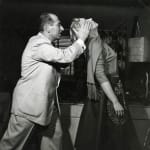John Kolisch
Substantial Archive of "The World's Fastest Hypnotist", 1950s-70s
Silver prints (approx. 280), and related ephemera
Most 8 x 10 inches, a few smaller
Many with various photographer's credit and / or date stamps verso.
Many with various photographer's credit and / or date stamps verso.
Further images
-
(View a larger image of thumbnail 1
)

-
(View a larger image of thumbnail 2
)

-
(View a larger image of thumbnail 3
)

-
(View a larger image of thumbnail 4
)

-
(View a larger image of thumbnail 5
)

-
(View a larger image of thumbnail 6
)

-
(View a larger image of thumbnail 7
)

-
(View a larger image of thumbnail 8
)

-
(View a larger image of thumbnail 9
)

-
(View a larger image of thumbnail 10
)

-
(View a larger image of thumbnail 11
)

-
(View a larger image of thumbnail 12
)

-
(View a larger image of thumbnail 13
)

A sprawling, multi-decade photographic documenting the career of John Kolisch who billed himself as “The World’s Fastest Hypnotist” (a claim we have been unable to verify). The collection contains nearly...
A sprawling, multi-decade photographic documenting the career of John Kolisch who billed himself as “The World’s Fastest Hypnotist” (a claim we have been unable to verify). The collection contains nearly 300 photographs of Kolisch performing mental miracles at various schools, lodges, halls, synagogues, private homes around the United States, as well as scripts and other production-related materials.
Included are images of participants from all walks of life, young and old, dressed in everything from tuxedos to shorts, all of whom have apparently-fallen under Kolisch’s sway. Eyes closed and spellbound, they are pictured dancing wildly, acting as furniture, removing their clothes, performing bawdy acts or gestures, or simply getting very, very sleepy. There are also many shots of Kolisch’s acts of Mentalism, including his signature routine of taping two silver dollars to his eyes to ensure he couldn’t peek, and then guessing how much change was in a subject’s pocket, or what they had written on a chalkboard.
The photographs come from a variety of different commercial studios and photographers, including Phyllis Twachtman, longtime photo-journalist for the World Telegram and the Three Lions Agency of New York City. There are a number of images with a “Tamarack Lodge” credit stamp. Located in Greenfield Park, NY, in the Catskills, the Tamarack was built in 1903 and was a popular spot on the Borscht Belt.
The archive’s printed and manuscript material includes a large packet of printed and typed, annotated material related to Kolisch’s lectures on “dynamic auto-conditioning” and “dynamic auto-suggestion;” a 17-page treatise titled “Your Incredible Subconscious Mind,” published in 1956 by the Subconscious Research Institute; and two notebooks with scripts, notes, and monologues related to Kolisch’s performances. Some of these are scripts or notes for specific TV performances including Cavalcade of Stars and a Warner Brothers talent show. There are jokes and patter for general routines. One groan-inducing section is titled “Funny Lines” and contains zingers to drop on hecklers or other unimpressed audience members. These razor-sharp barbs include “why don’t you sue your brain for non-support!” or “he’s got a photographic mind…too bad it never developed!”
Included are images of participants from all walks of life, young and old, dressed in everything from tuxedos to shorts, all of whom have apparently-fallen under Kolisch’s sway. Eyes closed and spellbound, they are pictured dancing wildly, acting as furniture, removing their clothes, performing bawdy acts or gestures, or simply getting very, very sleepy. There are also many shots of Kolisch’s acts of Mentalism, including his signature routine of taping two silver dollars to his eyes to ensure he couldn’t peek, and then guessing how much change was in a subject’s pocket, or what they had written on a chalkboard.
The photographs come from a variety of different commercial studios and photographers, including Phyllis Twachtman, longtime photo-journalist for the World Telegram and the Three Lions Agency of New York City. There are a number of images with a “Tamarack Lodge” credit stamp. Located in Greenfield Park, NY, in the Catskills, the Tamarack was built in 1903 and was a popular spot on the Borscht Belt.
The archive’s printed and manuscript material includes a large packet of printed and typed, annotated material related to Kolisch’s lectures on “dynamic auto-conditioning” and “dynamic auto-suggestion;” a 17-page treatise titled “Your Incredible Subconscious Mind,” published in 1956 by the Subconscious Research Institute; and two notebooks with scripts, notes, and monologues related to Kolisch’s performances. Some of these are scripts or notes for specific TV performances including Cavalcade of Stars and a Warner Brothers talent show. There are jokes and patter for general routines. One groan-inducing section is titled “Funny Lines” and contains zingers to drop on hecklers or other unimpressed audience members. These razor-sharp barbs include “why don’t you sue your brain for non-support!” or “he’s got a photographic mind…too bad it never developed!”












